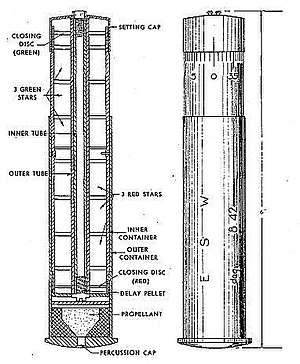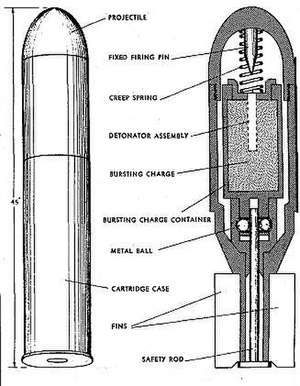Sturmpistole
The Sturmpistole (Assault-Pistol) was an attempt by Nazi Germany during World War II to create a multi-purpose weapon which could be used by any infantryman. It consisted of a modified Leuchtpistole or flare gun in English which could fire a variety of grenades, including a 600 g (1 lb 5 oz) shaped charge Panzerwurfkörper 42 which could penetrate 80 mm of rolled homogeneous armor. The idea was not pursued wholeheartedly, and took second stage to the then current anti-tank rifles and later weapon developments, such as the Panzerfaust and Panzerschreck.
| Sturmpistole | |
|---|---|
.jpg) A Sturmpistole with Panzerwurfkörper 42 being demonstrated to German troops, Russia (1943) | |
| Type | Flare gun |
| Place of origin | |
| Service history | |
| In service | World War II |
| Used by | Germany |
| Specifications | |
| Mass | 2.5 kg (5 lb 8 oz) |
| Length | Butt extended: 584 mm (23 in) Butt folded: 305 mm (12 in) |
| Barrel length | 180 mm (7.1 in) |
| Cartridge | Flare Smoke Panzerwurfkörper 42 Wurfgranate Patrone 326 Wurfkorper 361 |
| Caliber | 23 mm (0.91 in) |
| Action | Break action |
| Feed system | Single shot[1] |
Ammunition
The Sturmpistole was a multi-purpose weapon for signaling, illumination, target marking, or concealment with a smoke grenade. Later during World War II, explosive rounds were developed to give German troops a small and lightweight grenade launcher for engaging targets from close range which could not be engaged satisfactorily by infantry weapons or artillery without endangering friendly troops. Conversions of both the Leuchtpistole 34 and Leuchtpistole 42 are reported to exist. The conversion included adding a buttstock and sights for the different grenades.[2]
Sturmpistoles delivered to Romania were in use of Pioniere battalions.[3]
Available projectiles included:
- Multi-Star Signal Cartridge - This was a multi-star signal flare that contained three red and three green stars that could be set for six different color combinations.
- Panzerwurfkörper 42 - This was a HEAT grenade that could be used against enemy armor. It had a range of 69 m (75 yd) and could penetrate 80 mm (3.1 in) of RHA. It was similar in layout to the Wurfkorper 361 and used a rifled cartridge case.
- Wurfgranate Patrone 326 - This was a small, breech loaded, fin stabilized, explosive grenade, with a nose fuze that was designed for short range low angle direct fire missions. It was not recommended for use beyond 180 m (200 yd) due to inaccuracy or less than 46 m (50 yd) due to the risk from shell fragments.[2]
- Wurfkorper 361 - The Wurfkorper 361 was formed by screwing a bakelite or wooden stem into an Eierhandgranate 39 which allowed it to be fired from a Leuchtpistole. A brass or aluminum shell casing with propellant was first loaded into the breech of the gun. The stem was then slid down the muzzle until it slipped into the shell casing, the breech was then closed and the gun could be fired. The Wurfkorper 361 was used for high angle indirect fire where its shrapnel would be useful. The Wurfkorper 361 was not recommended for use at less than 46 m (50 yd) due to the risk from shrapnel and its maximum range was limited to around 78 m (85 yd) at 45° because the grenade had a 4.5 second time fuze.[2]
Photo gallery
.jpg) A Sturmpistole firing a HE grenade probably based on the Stielhandgranate 43.
A Sturmpistole firing a HE grenade probably based on the Stielhandgranate 43.- Leuchtpistole 34
- Leuchtpistole 42.
 Schematic of Multi-Star Cartridge components.
Schematic of Multi-Star Cartridge components. Schematic of Wurfgranate Patrone 326 components.
Schematic of Wurfgranate Patrone 326 components. Schematic of Wurfkorper 361 components.
Schematic of Wurfkorper 361 components.
References
- Gander, Terry (1979). Weapons of the Third Reich : an encyclopedic survey of all small arms, artillery, and special weapons of the German land forces, 1939-1945. Chamberlain, Peter. Garden City, N.Y.: Doubleday. p. 27. ISBN 0385150903. OCLC 5071295.
- United States. War Department. Military Intelligence Division (1943-01-01). Tactical And Technical Trends, Nos. 21-30.
- "Contribuții la istoria dotării cu armament a armatei române între 1944 și 1959" [Contributions to the history of the Romanian army endowment with weapons from 1944 to 1959]. Buletinul Muzeului Militar Național (in Romanian). 15. 2017.
- Robert A. Slayton, Arms of Destruction: Ranking the World's Best Land Weapons of WWII, Citadel Press, New York: Kensington Publishing Corp., ISBN 0-8065-2582-7
- Attack and assault guns of the Second World War (in Russian)
- Kampfpistole/Sturmpistole in Variations on the theme of detachable buttstocks (in Russian)
- 2.7 cm Leuchtpistole 38, and Kampfpistole Sturmpistole
- Sturmpistole in use of Romanian Pioniere units